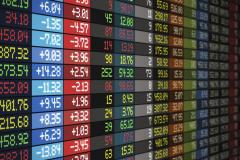
Following the market opening Tuesday, the Dow traded up 0.30 percent to 15,540.55 while the NASDAQ surged 0.33 percent to 3,730.07. The S&P also rose, gaining 0.29 percent to 1,702.52.
Top Headline
FactSet Research Systems (NYSE: FDS) reported a 5 percent rise in its fiscal fourth-quarter earnings. FactSet Research's quarterly profit surged to $51 million, or $1.16 per share, from $48.5 million, or $1.08 per share, in the year-ago period. Excluding one-time items, its adjusted earnings came in at $1.20 per share, versus analysts' estimates of $1.21 per share. Its revenue rose 5.6 percent to $219.3 million. FactSet Research had expected earnings of $1.18 to $1.21 per share on revenue of $218 million to $221 million. For the current quarter, FactSet Research expects earnings of $1.21 to $1.24 per share on revenue of $222 million to $225 million. However, analysts were projecting a profit of $1.23 per share on revenue of $224 million.
Equities Trading UP
Repros Therapeutics (NASDAQ: RPRX) shot up 29.82 percent to $27.60 after the company announced topline results from both the second pivotal efficacy study as well as the 6 month safety study of Androxal®. Shares of Kythera Biopharmaceuticals (NASDAQ: KYTH) got a boost, shooting up 26.04 percent to $42.26 after the company reported positive ATX-101 top line phase III trial results for the reduction of submental fat. Aeropostale (NYSE: ARO) was also up, gaining 16.75 percent to $10.05 after private equity firm Sycamore Partners reported that it had bought a 7.96 percent stake in the company.
Equities Trading DOWN
Shares of Outerwall (NASDAQ: OUTR) were down 16.03 percent to $47.00 after the company lowered its forecast for the third quarter and full year. Werner Enterprises (NASDAQ: WERN) shares tumbled 4.71 percent to $23.26 after the company issued a weak third-quarter profit forecast. Bank of America downgraded the stock from Buy to Neutral. Pandora Media (NYSE: P) down, falling 1.71 percent to $23.58 as the company announced its plans to sell 14 million shares of common stock, including 4 million shares from current stockholders.
Commodities
In commodity news, oil traded down 0.61 percent to $105.94, while gold traded down 0.35 percent to $1,313.20. Silver traded down 0.75 percent Tuesday to $21.85, while copper rose 0.39 percent to $3.23.
Euro zone
European shares were mixed today. The Spanish Ibex Index dropped 0.04 percent, while Italy's FTSE MIB Index rose 0.10 percent. Meanwhile, the German DAX dropped 0.04 percent and the French CAC 40 rose 0.04 percent while U.K. shares fell 0.18 percent.
Economics
The ICSC-Goldman Sachs store sales index dropped 1.6 percent in the week ended Saturday from the previous week. U.S. consumer prices increased 0.1 percent in August, while the core CPI also rose 0.1 percent. However, economists were expecting a 0.2 percent rise in both prices. The Johnson Redbook Retail Sales Index fell 0.3 percent in the first two weeks of September versus August. The NAHB housing market index remained at 58 in September. However, economists were expecting a reading of 58 in the month. August's reading was also revised to 58 versus an earlier estimate of 59. The Federal Open Market Committee begins its two-day policy meeting today. The Treasury is set to auction 4-and 52-week bills.
 Despite low yields, municipal bond funds still make sense for conservative investors interested in principal protection, modest income and diversification against their equity portfolios.
Despite low yields, municipal bond funds still make sense for conservative investors interested in principal protection, modest income and diversification against their equity portfolios. 

 ) reported that it has boosted its outlook for FY2014.
) reported that it has boosted its outlook for FY2014.
 Related BZSUM Dow Trades Above 17,000 While S&P 500 Inches Closer To 2,000 #PreMarket Primer: Thursday, July 3: Much To Consider Despite The Short Day
Related BZSUM Dow Trades Above 17,000 While S&P 500 Inches Closer To 2,000 #PreMarket Primer: Thursday, July 3: Much To Consider Despite The Short Day